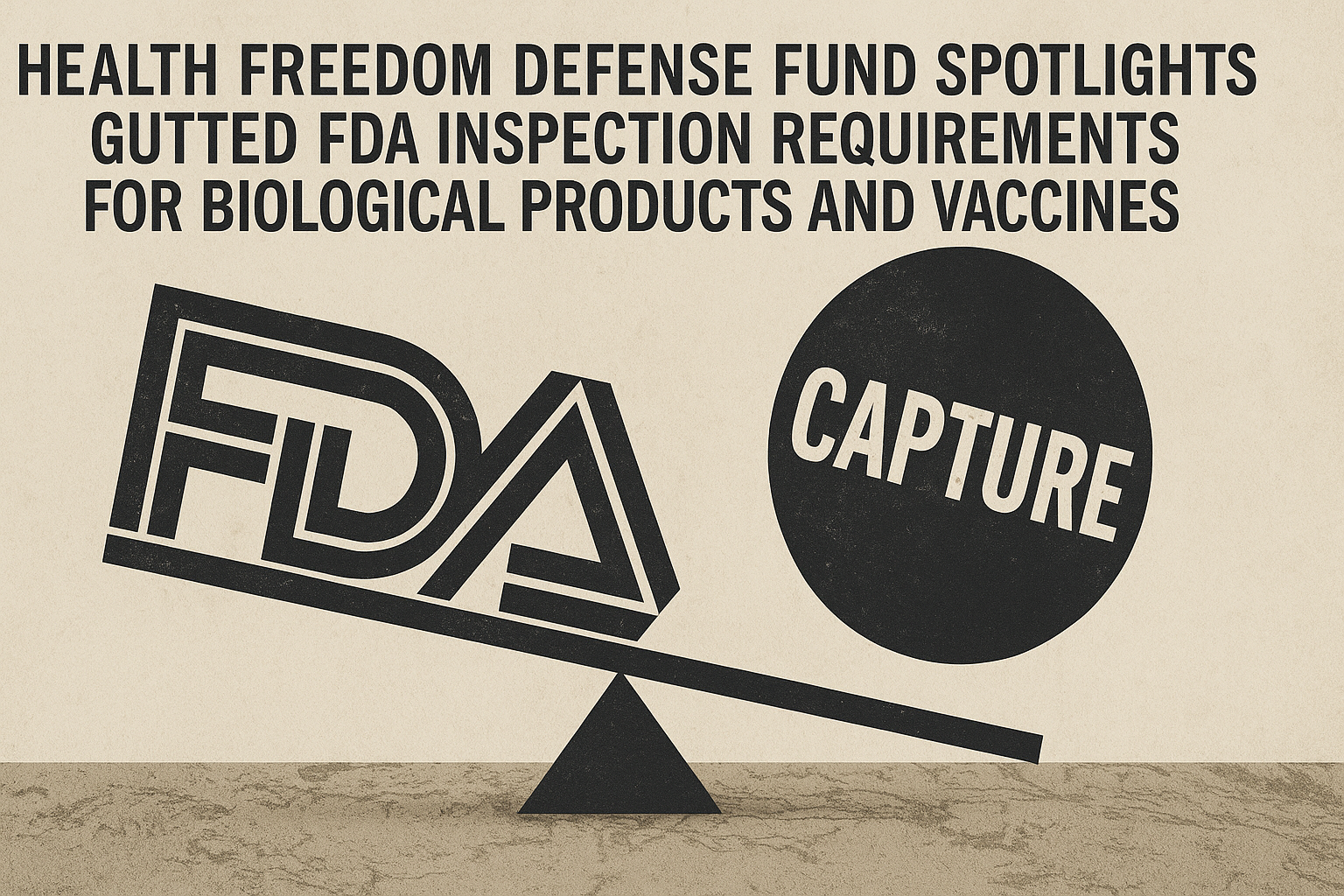
The influence of the pharmaceutical industry on the Food and Drug Administration (FDA) has been recognized with concern for decades across the political spectrum. But the industry's influence on Washington DC is also strongly bipartisan, and the struggle for the soul of the regulator is still a hotly contested one to this day, even as promising reforms are being considered or initiated under the current administration.
Health Freedom Defense Fund (HFDF) strongly protects absolute personal choice in all medical and health decisions. Unfortunately, any federal or state regulatory agency subjected to "regulatory capture" provides the public with potentially unreliable data to make those very decisions related to medicines and vaccines.
More fundamentally, even if data were reliable at first, manufacturing inspection standards must be high at these facilities to guarantee the product studied and regulated initially by the FDA, is materially the same as the product being manufactured for public use. Adulterated or contaminated medical products can lead to lack of efficacy, injury and death, and manufacturing defects are becoming a greater problem each year for the industry, with more than 300 recalls each year.[i]
Currently, the vaccine industry is protected by several layers of legal protection that protect it from legal liability if a drug is adulterated or contaminated. The first is the PREP Act emergency declarations (still in place) for pandemic influenza and covid-19 which protects all manufacturers of "covered countermeasures" and those that administer them, from any civil liability. The second layer is the National Childhood Vaccine Injury Act which guarantees liability immunity to most vaccines generally.
But even were an improved scenario implemented where vaccines were on the same playing field as other drugs in its category (biologics), and both these legal instruments were removed by declaration and legislation respectively, there is a still third layer of protection provided to industry: quietly-lowered standards for regular, meaningful inspections.
A Rule Change with Serious Implications for the Health of the American Public
Dr. Scott Gottlieb stands above all other FDA Commissioners in terms of his financial involvement with industries that are regulated by the agency he led, both before and after his multiple stints at the FDA, including his tenure as Commissioner.[ii] These included venture capital healthcare funds, health insurance plan providers, vape producers, and leadership roles at drug companies like Pfizer, Bristol Myers Squibb, and GSK.
In April and May of 2019, before the covid-19 crisis, Commissioner Gottlieb oversaw a change in the Code of Federal Regulations pertaining to requirements for inspection of all biologics (vaccines, cancer drugs, blood products, monoclonal anitbodies, etc). In this move the FDA critically removed the two year minimum requirement for inspections for drug manufacturers, and removed key responsibilities for inspectors themselves.
In practice, the changes mean fewer regular inspections, with the FDA only conducting inspections when the Commissioner deems it needed, based on a vague "risk-based" assessment. Additionally, critical post-inspection actions moved from inspectors to the discretion of the Commissioner.
Of course, one of the pharmaceutical industry's major costs is manufacturing, quality assurance and quality control engineering, as well as FDA inspection management teams. But the reasons for this change go beyond mere profit motive for industry, to potential protection of certain drugs or platforms.
While many FDA inspections may continue to be reasonably-timed, professional, and ongoing, this intentional removal of a minimal, baseline frequency requirement allows the FDA and the Commissioner specifically to pick "winners" through fewer inspections, and "losers" through overly onerous inspection should he so choose. Additionally, it allows plausible deniability for Commissioners to claim they are not at fault for a dangerous production site not being inspected for many years or even a decade, and to blame the "risk score" instead.
With this change in the FDA rules, an industry-connected Commissioner enjoys an even more powerful position; one that tilts power toward Washington DC without even providing meaningful safety inspections and drug reliability as a trade-off. Some favored drug companies or entire sectors, like mRNA technology firms, could enjoy many years without any manufacturing inspector's attention, based on a staffer's dubious risk assessment.
Or even worse, if there were negative inspection reports, these could merely be ignored-- even more easily when it comes to a PREP Act protected countermeasure, which has no liability exposure. This exact scenario happened, when repeated poor inspection results at a US-based mRNA injection production facility were in fact released in 2020 and 2022, without any known follow up as to corrective action or whether the issues were satisfactorily addressed.[iii][iv] In situations like this, the FDA Commissioner holds all the cards since the changes of 2019.
Specifics of the Changes to Federal Rules: A Risk-Based Approach Ripe for Abuse
The language removed from the agency's rules about inspection timing are as follows:
In case the license is denied following inspection for the original license, no reinspection need be made until assurance has been received that the faulty conditions which were the basis of the denial have been corrected. An inspection of each licensed establishment and its additional location(s) shall be made at least once every 2 years [emphasis ours]. Inspections may be made with or without notice, and shall be made during regular business hours unless otherwise directed.[v]
Currently, only the sentence preceding that paragraph remains. The only requirement left to be found in the entire Federal Registry about minimum timing of FDA Biological product inspections is the self-evident point that it should not happen before a product is being manufactured:
"The inspection of an establishment for which a biologics license application is pending need not be made until the establishment is in operation and is manufacturing the complete product for which a biologics license is desired." [21 CFR 600.21]
The FDA claims this change is simply made to remove "outdated" inspection requirements in favor of new, risk-based inspections:
The proposed revision and removal of certain general biological products regulations are designed to eliminate outdated requirements and accommodate new approaches, such as a risk-based inspection frequency for drug establishments and provide flexibility without diminishing public health protections.[vi]
In justifying this change, the FDA unhelpfully note that the changes don't impact other, unrelated existing regulations in the Food Drug & Cosmetic (FD&C) Act or the Public Health Act, or inspectors' manuals, none of which have any minimal requirement for the timing or cadence of inspections beyond outlining the vague "risk-based" approach. They are full of inspection process details, reporting requirements, and other specifics, but no minimal, baseline requirements for inspection timing.
This change went largely unnoticed, except by independent legal researcher Katherine Watt, who has helpfully compiled the CFR changes for reference.[vii] As a sign of the quiet passage of this change, only five comments from the public were received during the rule change discussion period.
In their response to one public comment, the FDA admits that "the risk-based inspection schedule for drug and device establishments may result in scheduling inspections at intervals of greater than 2 years for certain biological product establishments. However, those establishments will have been determined to be at a lower risk..."[viii]. In other words, the public must trust that the FDA can predict which facilities, companies, and technologies present the biggest risk.
Even if FDA inspections do follow a systematic "risk-based" schedule of some type, it is still entirely at the discretion of the Secretary of HHS according to the Food Drug and Cosmetic Act:
The Secretary, acting through one or more officers or employees duly designated by the Secretary, shall inspect establishments described in paragraph (1) that are engaged in the manufacture, preparation, propagation, compounding, or processing of a drug or drugs (referred to in this subsection as ‘‘drug establishments’’) in accordance with a risk-based schedule established by the Secretary.[ix]
Unsurprisingly, the list of risk categories ends with the all-encompassing "any other criteria deemed necessary and appropriate by the Secretary for purposes of allocating inspection resources." This provides the Commissioner full control of the risk metrics, as well as the timeline and application of them to regulated companies.
Outside of timing of inspection, the elimination of inspectors' specific duties and responsibilities was significant and curious in the rule change. Inspectors largely would do the same job, and generate a publicly-available Form 483 which details issues that the inspector identifies as drivers of facility or management problems, contamination or adulteration. However, they are no longer required to "make recommendations as to action deemed appropriate with respect to any application for license or any license previously issued.[x] " In other words, the inspectors could no longer clearly call for accountability at a meaningful level of licensure. That language was removed and not replaced.[xi]
In other words, their inspection findings no longer lead to an explicit recommendation that a manufacturer's license should be pulled or suspended. Rather, that process now moves to the non-publicly-available FDA bureaucracy, and ultimately the Secretary.
With these changes, under Commissioner Gottlieb the transition to full Commissioner discretion was completed with some seemingly minor changes to the Federal Register. The application of FDA inspection teams was thereafter guaranteed to be uneven, and the baseline quality standards the public assumes are in place were undermined.
Personal and Institutional Drift Toward A Conflicted FDA
How did we end up with an FDA that has such a non-adversarial posture toward the industry it regulates? The issues on one level are structural financial conflicts. Pharmaceutical companies directly pay "user fees" with their drug license applications that make up between 68% to 75% of the FDA’s Drug Division annual budget.[xii] While sold to the public and congress as a reasonable way to share the burden of costs at the agency given the highly technical nature of data assessments and facility inspection team, the effect is of course predictable when an industry pays for salaries and costs indirectly via the FDA user fee program, that industry will predictably not receive the same level of scrutiny required for the protection of the public from adulterated or mislabeled drugs.
On another level, there are personal conflicts. The "revolving door" of leadership between pharmaceutical companies and the regulatory agencies that are supposed to oversee them continues, with the last FDA commissioner who did not work for pharmaceutical companies in some capacity after their tenure being David Kessler, who was appointed in 1990 and served seven years.[xiii] In recognition of the public's skeptical view of this reality, current FDA Commissioner Makary pledged publicly to divest all holdings and financial ties to the companies he had previously worked with.
Even administrators that had no obvious financial ties to industry often acted seemingly on their behalf. One such leader is Janet Woodcock, the acting FDA Commissioner during much of the covid-19 crisis and instrumental regulator during the start of the opioid epidemic.[xiv] She was found to be the most industry-favored commissioner candidate, even above industry veteran Robert Califf, in an informal poll by pharmaceutical industry expert John Mack, and subsequently was publicly supported by clinicians who themselves receive funding from industry during the Biden administration (she was appointed as acting FDA Commissioner on day 1).[xv]
But the issue is not only agency leadership. Even to the level of the FDA's medical reviewers, one study in the British Medical Journal found that among those reviewers who left the FDA, at least half (57%) took jobs in the pharmaceutical industry.[xvi] This alone does not immediately suggest wrongdoing in individual cases, but creates a clear appearance of a larger conflict of interest that has never been adequately addressed. Moreover, when over half of FDA drug reviewers depart the agency and land at cushy jobs in industry, the American public must rightfully question where those employees’ priorities lie.
Overall, the FDA and its relationship with the industries it regulates must be a subject of transparent reform and scrutiny, and this is a particularly acute situation when it pertains to medicines that are pushed on the public without adequate informed consent or with coercive economic or institutional mandates. Unreliable data combined with low quality vaccines or drugs will lead to bad decisions and terrible health outcomes.
For a country with a disastrous chronic disease crisis currently underway, the US simply cannot afford to continue on the current path. Bringing back basic standards of manufacturing inspection is a necessary though not sufficient step to minimize harm to the public, and to begin to justify the existence of the FDA as an institution worthy of public trust.
[i] https://www.sciencedirect.com/science/article/abs/pii/S0731708524003893
[ii] https://www.citizen.org/article/outrage-of-the-month-revolving-door-to-fda-commissioners-office-sows-distrust-in-agency/
[iii] https://www.statnews.com/wp-content/uploads/2022/09/Catalent-Biologics-Bloomington-Indiana-9.2.20-483.pdf
[iv] https://www.fiercepharma.com/manufacturing/fda-cites-catalent-issues-indiana-plant-which-caused-delay-moderna-booster
[v] https://bailiwicknewsarchives.wordpress.com/wp-content/uploads/2023/12/2019.04.02-version-21-cfr-600.21-time-of-inspection-before-new-rule-time-of-fda-inspection-every-2-years.pdf
[vi] Federal Register / Vol. 84, No. 63 / Tuesday, April 2, 2019 / Rules and Regulations]
[vii] https://bailiwicknews.substack.com/p/legalized-fda-non-regulation-of-biological
[viii] Federal Register / Vol. 84, No. 63 / Tuesday, April 2, 2019 / Rules and Regulations 12507
[ix] FEDERAL FOOD, DRUG, AND COSMETIC ACT Sec 510
[x] https://bailiwicknewsarchives.wordpress.com/wp-content/uploads/2023/12/2019.04.02-version-21-cfr-600.22-duties-of-inspectors-before-new-rule-duties-of-fda-inspector-8-enumerated.pdf
[xi] https://bailiwicknewsarchives.wordpress.com/wp-content/uploads/2023/12/2023.12-current-version-21-cfr-600.22-duties-of-inspectors-none-enumerated.pdf
[xii] https://www.forbes.com/sites/johnlamattina/2022/09/22/why-is-biopharma-paying-75-of-the-fdas-drug-division-budget/
- [xiii]Scott Gottlieb (2017–2019): Joined Pfizer's board shortly after leaving the FDA. GSK, BMS, etc.
- Robert Califf (2016–2017 and 2022–2025): Held consulting roles and board positions with companies like Cytokinetics and Verily (Alphabet's life sciences division) between stints, with salary support from firms like Merck and Bristol-Myers Squibb as researcher.
- Stephen Hahn (2019–2021): Became chief medical officer at Flagship Pioneering, a biotech firm.
- Margaret Hamburg (2009–2015): Joined the board of Alnylam Pharmaceuticals.
- Andrew von Eschenbach (2006–2009): Served on biotech boards like BioTime and consulted for pharmaceutical firms.
- Mark McClellan (2002–2004): Joined Johnson & Johnson's board.
- Jane Henney (1999–2001): Served on boards of AstraZeneca and other health-related companies.
- Lester Crawford (2005): Worked as a lobbyist for pharmaceutical interests.
[xiv] https://www.theguardian.com/us-news/2021/jan/28/fda-janet-woodcock-opioids-biden
[xv] https://pogoblog.typepad.com/pogo/2011/08/fdas-janet-woodcock-the-substance-behind-her-nonsubstantive-substantive-ties-to-industry.html
[xvi] https://www.scribd.com/document/415679600/Future-jobs-of-FDA-s-haematology-oncology-reviewers-Bien-2016














